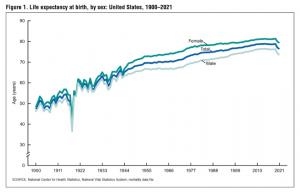Take a look in this Formaspace Executive report at what health researchers recommend for living a longer “health span.”
Newly popular anti-aging treatments include “ozone therapy,” in which a patient’s blood is drawn, supplemented with dissolved ozone, and returned to the patient via an IV drip.”
AUSTIN, TX, UNITED STATES, December 30, 2024 /EINPresswire.com/ -- Public Health Officials Report that Life Expectancy in the US Declined Significantly in 2021. Are We Headed in the Wrong Direction?— Formaspace
Life expectancy in the US increased significantly throughout the nineteenth century. However, we seem to have reached a plateau around the year 2010, followed by a very slight downward trend.
Then the Covid pandemic hit in 2020, which has led to a sharp decrease in life expectancy.
If we zoom in on the data from the chart above, the life expectancy for U.S. women born in 2021 dropped below 80 years.
The outlook is worse for men.
Men born in 2021 are only projected to live until 73.5 years of age – a 2.8-year decrease from 2019.
Some Individuals are Spending Hefty Sums to Reverse the Aging Process
Hopefully, the increased mortality from the Covid virus won’t repeat any time soon, and statistical life expectancies will quickly return to pre-Covid levels.
Nevertheless, the once widely-held optimism of public health and healthcare providers – many of whom once claimed that living to 100 or beyond would be commonplace by now – has tempered significantly.
But that doesn’t mean that individuals aren’t trying to break the lifespan barrier; indeed, there is a new class of “age avoiders” that, in the words of the Wall Street Journal, believe “outliving your peers is now a competitive sport.”
Leading the charge for living an extended life is David A. Sinclair, PhD, whose book “Lifespan: Why We Age―and Why We Don’t Have To” is a bible among longevity advocates – and a lightning rod for Sinclair’s many critics.
What are some of the anti-aging protocols promoted by longevity advocates?
· Full Body MRIs
The company Prenuvo is offering full-body MRI scans to identify any potential early-stage tumors or other anomalies. The estimated cost is circa $2500. Early backers of the company include former Google CEO Eric Schmidt and supermodel Cindy Crawford.
· Anti-Aging IV Ozone Injections and Supplements
One of the most prominent members of the “biohacker” longevity community is Bryan Johnson, a tech company billionaire who purportedly spends $2 million a year on treatments, including massive stem cell injections. (Johnson also wants to build a “don’t die” nation-state dedicated to the longevity lifestyle.)
Other newly popular anti-aging treatments include “ozone therapy,” in which a patient’s blood is drawn, supplemented with dissolved ozone, and returned to the patient via an IV drip. Other therapies on offer include vitamins, supplements, or even salmon DNA injections (the latter reportedly promoted by Kim Kardashian to achieve more youthful skin.)
· Reprogramming Cells and Brain Transplants
Replacing aging organs is another approach being pursued by longevity advocates. Jean Hébert of the US Advanced Projects Agency for Health (ARPA-H) and author of the book “Replacing Aging” is reported to be spearheading long-term brain therapies that would introduce “youthful” brain tissue made in a lab. (DOI 10.3390/bioengineering10020263)
Meanwhile, Richard Klausner of Altos Labs has reportedly received over $3 billion in funding to create therapies that “reset” human DNA epigenomes, essentially reprogramming them in hopes of reversing the aging process.
The Rise of a New Metric for Healthy Living: “The Health Span”
How will we view these longevity therapies in the future?
Will these advocates for extreme longevity be accepted as revolutionary pioneers by tomorrow’s mainstream medicine practitioners – or dismissed as well-meaning but misguided pied pipers chasing the mythical fountain of youth?
Time will tell.
However, the impact of extreme longevity advocates may already be felt in one significant area – the rise of “health spans” as a metric of public health.
What is a “health span” exactly?
It’s quite simple. Rather than focus on how many years we live before we die, “health span” measures how many years we live as healthy individuals – before we succumb to debilitating health conditions that require significant long-term geriatric care.
Health Researchers Discover that We Age More Rapidly at Two Points in Our Lives
Another major tenet of the anti-aging movement that is gaining mainstream adoption is the rise of tests that seek to measure an individual’s equivalent biological age.
One prominent company offering biological-age blood tests is TruDiagnostic, based in Lexington, Kentucky, which is at the heart of a healthy living competition in which, according to the Wall Street Journal, around 8,000 people are competing to achieve the slowest “pace of aging.” Other companies offering these tests include Elysium, which evaluates saliva samples to assess epigenetic markers indicative of biological age.
New research may give us new insights into the pace of aging throughout our lives. Aging is not a linear process as many have assumed.
Read more...
Julia Solodovnikova
Formaspace
+1 800-251-1505
email us here
Visit us on social media:
Facebook
X
LinkedIn
Legal Disclaimer:
EIN Presswire provides this news content "as is" without warranty of any kind. We do not accept any responsibility or liability for the accuracy, content, images, videos, licenses, completeness, legality, or reliability of the information contained in this article. If you have any complaints or copyright issues related to this article, kindly contact the author above.




